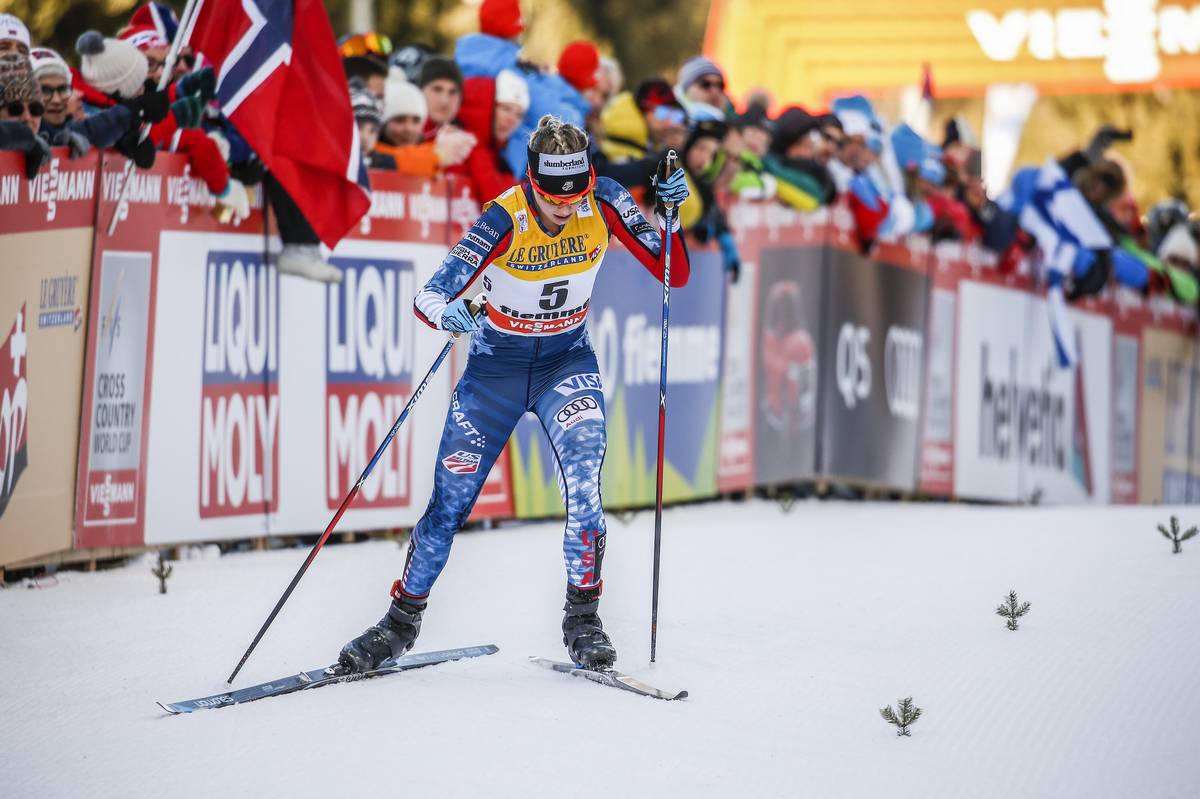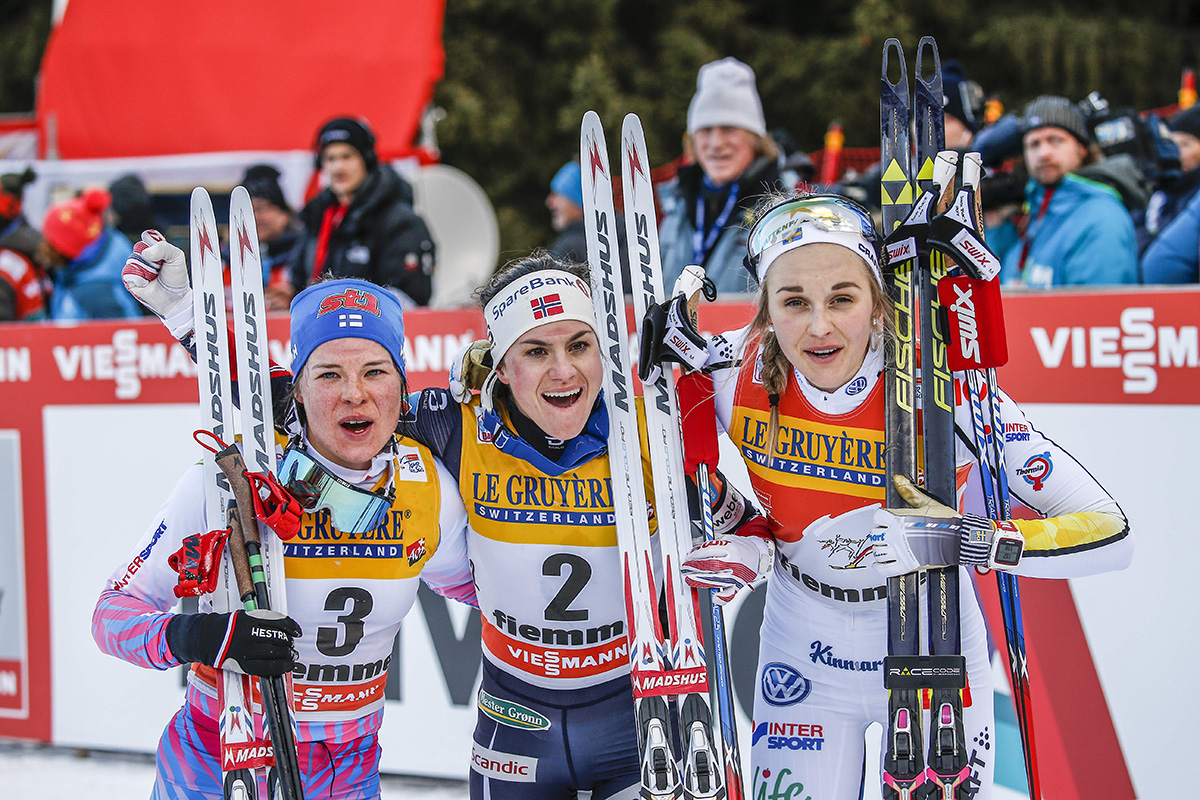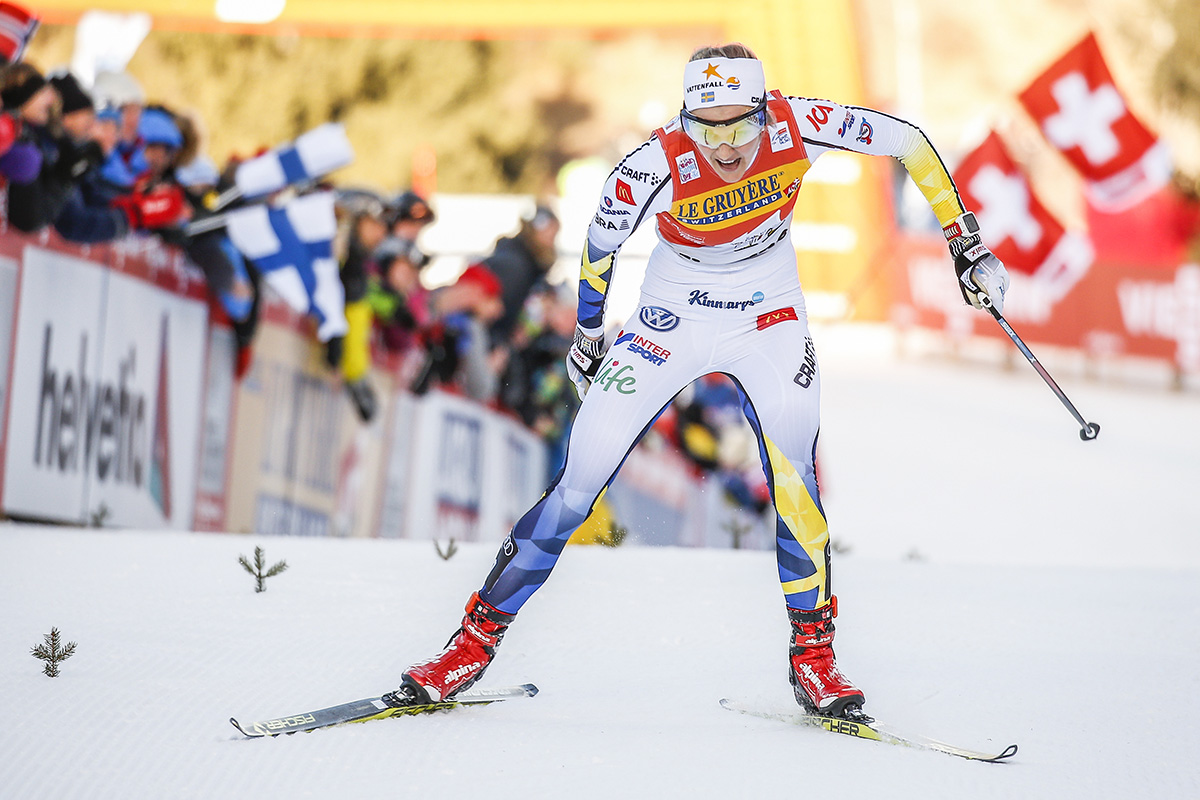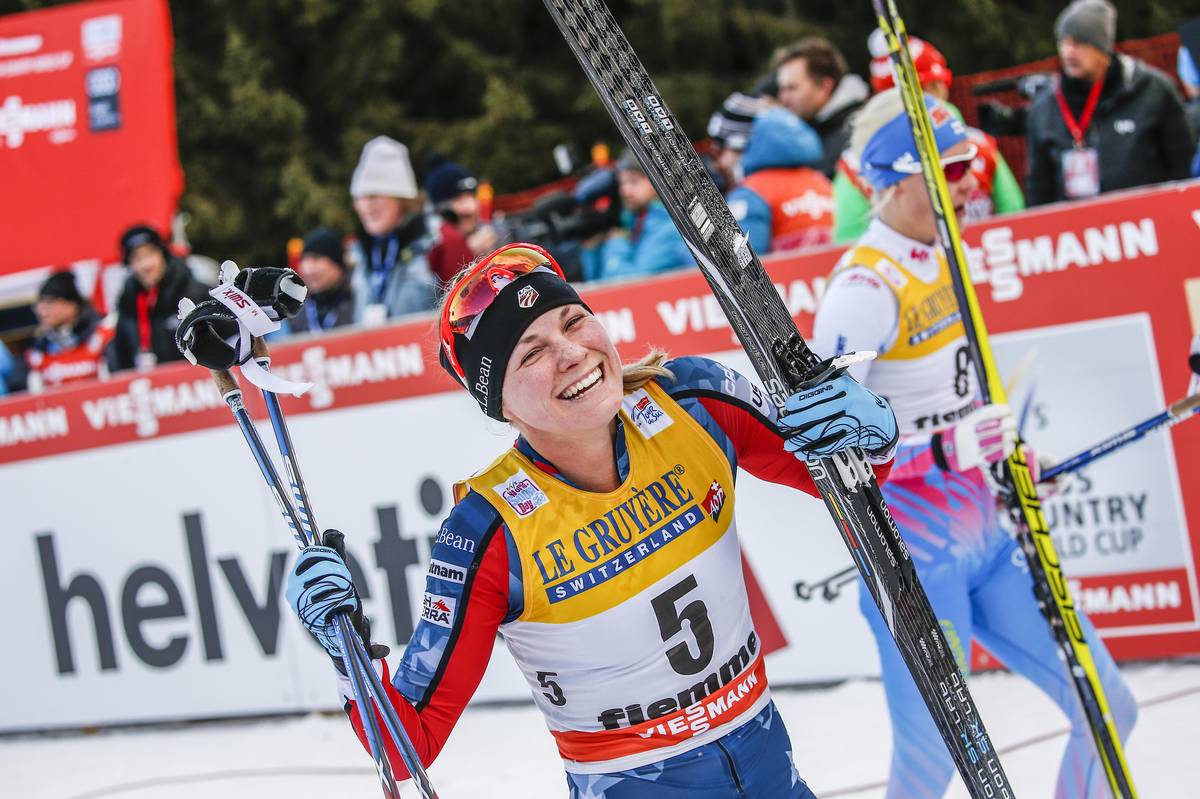
Sweden’s Stina Nilsson didn’t fancy herself a favorite for this year’s Tour de Ski title, despite having won four stages and wearing the leader’s bib to start out today’s final race.
And after about six kilometers of the 9-kilometer climb up the Alpe Cermis, everyone knew why.
Heidi Weng, a Norwegian who had started 19.2 seconds behind Nilsson, had slowly gained ground on the Swede in the flat sections leading up to the climb itself. At 6.2 k, she caught Nilsson.
Weng barely paused and certainly never looked back. Instead, she stepped on the gas. Weng clocked the fastest time up the hill of any woman in the field and skied to a 1:37.0 win for her first-ever overall Tour de Ski title.
Weng, in tears during interviews, was overcome at winning her first major title. She has had dozens of podiums, including three in the overall Tour de Ski and one after the Ski Tour Canada last season. But she had yet to collect a tour win.

“Today it was finally my turn!” Weng told NRK.
Climbing, though, is a strong suit of hers. And she received some motivation from teammate Therese Johaug, who has won both the Tour de Ski and the final climb before but is sidelined for a doping violation.
Johaug called Weng on Saturday, according to Norway’s VG news service.
“Therese said, ‘You can do it. You are a machine climbing.’ And I thought, ‘Such a machine, that’s not me.’”
But she was, matching Johaug’s time from the previous year (although snow conditions were different).
“It’s crazy big – it hasn’t dawned on me yet,” Weng told VG. “It has been an exhausting tour… I was nervous all the way and now I’m ecstatic.”
After getting dropped by Weng, Nilsson’s trials still weren’t over. The rest of the field was coming for her too. They knew that the previous year she had skied just the 40th-fastest time up the climb and guessed that she was likely to be suffering again this time around.

Nilsson has improved a lot in the last year – her many World Cup wins and podiums can attest to that. And she cut her margin to the leader in the climb time more than in half this year, from 5:57 behind Therese Johaug in 2016 to 2:13.6 behind Weng this time.
But she was still suffering. And at 8.1 k, Krista Parmakoski of Finland caught her.
Parmakoski had skied out of the start in third place, and made up 54 seconds on Nilsson. She appeared exhausted, and rather than blowing by the Swede as Weng had done stayed behind her for a bit. But then she, too, moved past and opened up a gap that grew to 17.4 seconds at the finish.
“I had a really good day,” Parmakoski told FIS. “I have been many times fourth, so it is great to be on the podium. Today I felt great and surprisingly fast on the climb.”
But even then, Nilsson wasn’t out of danger in her quest for a podium.
Ingvild Flugstad Østberg, whose hopes of a Tour title had been dashed by a rough 10 k the day before and who had started fourth, was on the hunt.
The Norwegian had Nilsson in her sights and appeared to be making up ground. But Nilsson buckled down on the climb’s upper reaches and sprinted it in to the finish, podium secure.
“For the first time I wish the course was a little longer,” Østberg lamented to NRK.
“I’m very pleased with how I held it together,” Nilsson told Expressen. “I tackled this much better than I have all year… I’m so glad I made the bronze. It was so nice to snag third place! I was glad I had a sprint when Ingvild closer to the end, because I had no desire to come in fourth.”
Østberg was disappointed to be off the podium, but congratulated her Swedish rival.
“It was a bitter, sour fourth place for me,” she told Expressen. “But it is well deserved for Stina get a podium when she won so many races.”
Diggins Secures Fifth, Tying Best U.S. Result
Jessie Diggins had started the day in fifth place, and came in with dual ambitions: “chase fourth, but protect fifth.”
“I knew that there was some good climbers behind me,” the American skier explained in a phone interview. “And I knew that I had to have a decent day to hold them off, because things can change dramatically on that hill. So I was trying to catch Østberg, but part of my plan was… don’t blow up so badly that we lose what I already had.”
She has been making steady progress in managing the final climb. In her first go-rounds, in 2013 and 2014, she clocked the 20th-fastest times up the hill; in 2016 she was 15th; and today, her time came in 11th.
“In past years I have tried to catch people right at the base of the climb, and if you blow up there you are screwed,” Diggins said. “You can just bleed minutes of time. I really wanted to be going as hard as I could right before blowing up if that makes sense, find that line and ride it. Then at the end I really started trying to push, but… I started losing time because I was just getting extremely fatigued. But I think this is one of my better climbs because I was able to not just blow myself open.”

Diggins had closed in on Østberg, and was at one point quite close. But feeling under threat – and maybe simultaneously perceiving that third place might be within her reach – Østberg pulled away.
“I was trying to hang with Østberg, thinking maybe if it comes to a sprint-off I could get her, but I wasn’t trying to sprint up to her to close the gap because I knew that would have disastrous results,” she said. “At one point I was like 25 feet behind her, but then I couldn’t quite hold on. She was so mentally strong, she really galvanized me at the end. I kept my spot; I was really happy to finish in fifth.”
That ties Diggins for the best American finish ever in the Tour de Ski, a mark set by Liz Stephen in 2015. Diggins also finished fifth in last year’s Ski Tour Canada.
“I mean any time you can be like Liz Stephen it’s a really good day,” Diggins laughed.

But besides her own efforts, she was impressed with the whole team that made it possible for her to have a top overall result.
“It takes an immense effort from the wax tech and the staff, and the massage and physical therapists, and the athletes and everyone — being positive and staying on it,” she said. “To be able to string together race after race, without any of them being bad, without losing your overall place in the Tour. You’re bound to have a day that is not great, but you need to be able to put together solid enough performances to keep going.”
Not just in the context of a Tour, but in terms of the World Cup season, that has been a goal for Diggins.
“It’s something that I have been working on, is consistency through my skate and classic and sprint and distance,” Diggins said. “So that’s what I am really proud of because I have been working towards it.”
Stephen Second-Fastest Up Hill, 14th Overall; Brennan 28th
The U.S. Ski Team’s Liz Stephen was making a bid to win the hill climb. Doing so would have made her the fourth U.S. woman in history to notch a Tour de Ski stage win behind Kikkan Randall, Sophie Caldwell, and Diggins.
She came up just short, finishing 38.2 seconds behind Weng’s fastest time up the Alpe Cermis. Nobody else came closer.
“I wanted to win today for sure,” Stephen said. “It was a really good opportunity. I knew I would have to do a really good race to beat Heidi, but it was definitely the goal. So I was a little disappointed for sure with second — which sounds ridiculous, but the win was the goal.”
The U.S. team has set a culture of high expectations, and for years this has been the favorite day of a favorite race series for Stephen. This was the fourth time she has finished second in the climb, and she really wanted the win.
“You set out to win every day, but actually you have a realistic goal as well, generally, in your brain,” she said. “I think today it was realistic for me to win. Anytime you miss the goal that you set for yourself, you have a little bit of disappointment.”
But, she tried to also pick out some reasons to feel good about her race.
“It definitely does play a role I think that Heidi was going for her first Tour de Ski win… and to have $100,000 on the line, I am sure that also gave her even a little extra motivation,” Stephen said. “She was on fire today, and I never mind losing to Heidi. She is a hell of an athlete and a really fun person to know and I am really happy for her.”
For Stephen, disappointment means looking ahead. In 365 days (more or less), she’ll have another chance.
“I guess I have already set my sights on next year,” she said. “I want to win this thing before I retire. So we’ll see, maybe a little extra training for it specifically next year. I don’t know, maybe not. But yeah, I will try to do it again next year and see how it goes.”
Teammate Rosie Brennan started in a wave of five women at eight minutes behind Nilsson, and was the first from the wave to cross the finish line.
“The flat section is really narrow, and really hard to pass people,” she said in a phone call. “[The wave] is kind of a toss up: the flats are definitely hard for me, so it’s nice to be able to draft, but also when you’re going for time of day, it’s nice to have space to go when you want to go.”
When she got to the actual climb, Brennan began to feel better. The day before, she had surmised that the climb is actually straightforward when you’re tired. All that’s required is to just put one foot in front of the other.
“I tried to just chip away once we started the climb, and maybe a third of the way up it I started feeling pretty good,” she said. “I tried to move up a bit, and was able to pass a few people. Then I just held steady because at that point I was in no man’s land.”
With nobody close enough to catch, Brennan crossed the line 26th. Once her time was adjusted to account for the wave start, she was 28th overall.
“I’m happy with how the Tour finished,” she said. “The start was okay and the middle was really rough. Then I came around a little bit at the end. I really like tours, but it’s very challenging to put together a good tour. To be top ten even in a tour is an incredible accomplishment for anybody. It’s so hard to not lose time on any given day. I’m happy I was able to stick it out, and turn things around in the last few days. I’m satisfied with that, and hopefully I’ll get another chance next year.”
Looking to Refresh
Diggins, who was on the massage table during her interview, was very much looking forward to some rest and recovery.
“We’re going to go spend one day here [in Val di Fiemme] and then we are going to go up to Seiser Alm, which is where we usually go for our training camp,” she said. “It’s high altitude. It’s great living, we know the skiing is good, the food is good, so it’s a good place to kind of recover and regroup. And I plan on going sledding every day.”
For Stephen, a goal will be to keep the mindset she was able to achieve by the end of the Tour.
“I think this tour helped me get much better, not only in my physical state — I think that all of this racing has really helped where I am physically right now — but also, I think the daily race efforts mentally really get me going again,” she said. “The best thing sometimes this tour does for me is just puts me into race mode. Now the challenge will be, well, first to rest, but then to figure how to keep so mentally psyched and engaged in the sport I am doing … Hopefully I can rest a little bit and then get some really good training in and look forward to World Champs, and even the [World Cup] races in Sweden.”
Brennan won’t travel with the team but instead will do a recovery and training camp outside of Seefeld, Austria.
“It’s just to mix things up and take a break,” she said of her choice of Seefeld.
She will then rejoin the U.S. team in Sweden for World Cups.
“I had a little bit of a slow start to the season, and then in France I was finally able to turn things around,” she said of the pre-Christmas races. “But then I got really sick over Christmas. To be able to turn in this Tour makes me believe I’m okay, after that. It just took a while to get my energy back from that illness. Now I have the confidence that I will be able to take a rest, and train a little bit, and be back where I want to be come Sweden.”
Chelsea Little
Chelsea Little is FasterSkier's Editor-At-Large. A former racer at Ford Sayre, Dartmouth College and the Craftsbury Green Racing Project, she is a PhD candidate in aquatic ecology in the @Altermatt_lab at Eawag, the Swiss Federal Institute of Aquatic Science and Technology in Zurich, Switzerland. You can follow her on twitter @ChelskiLittle.



